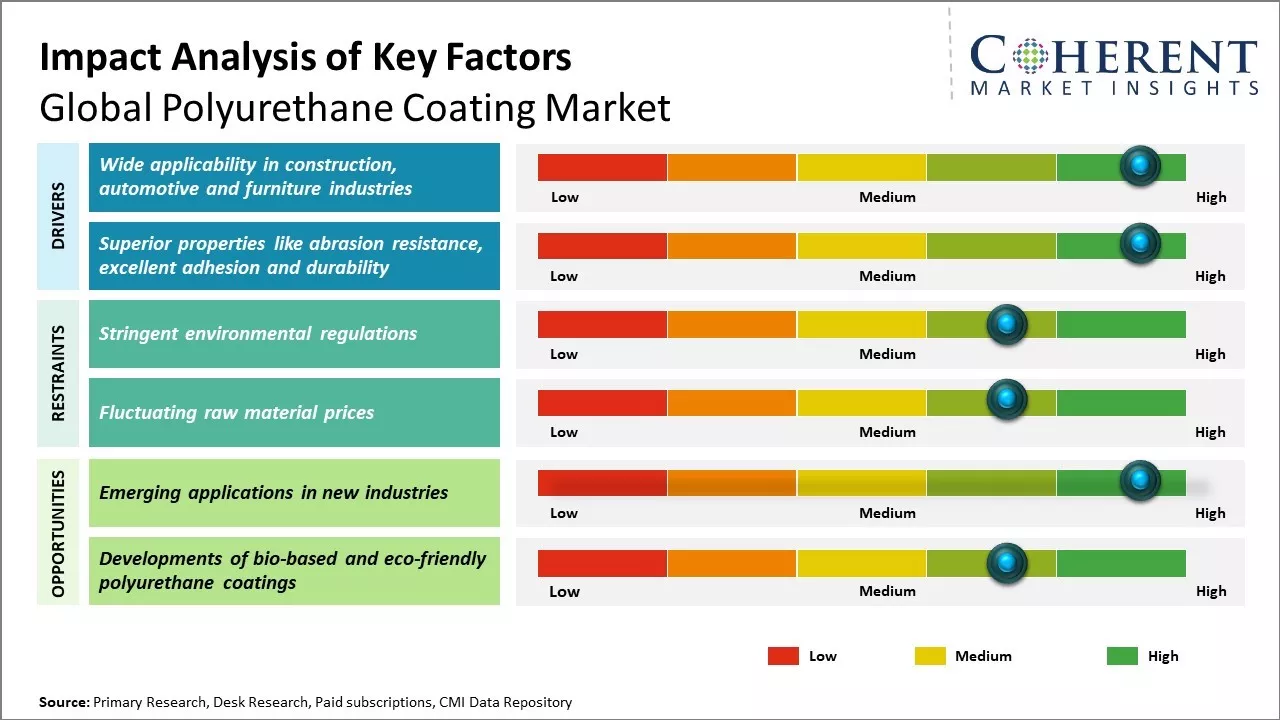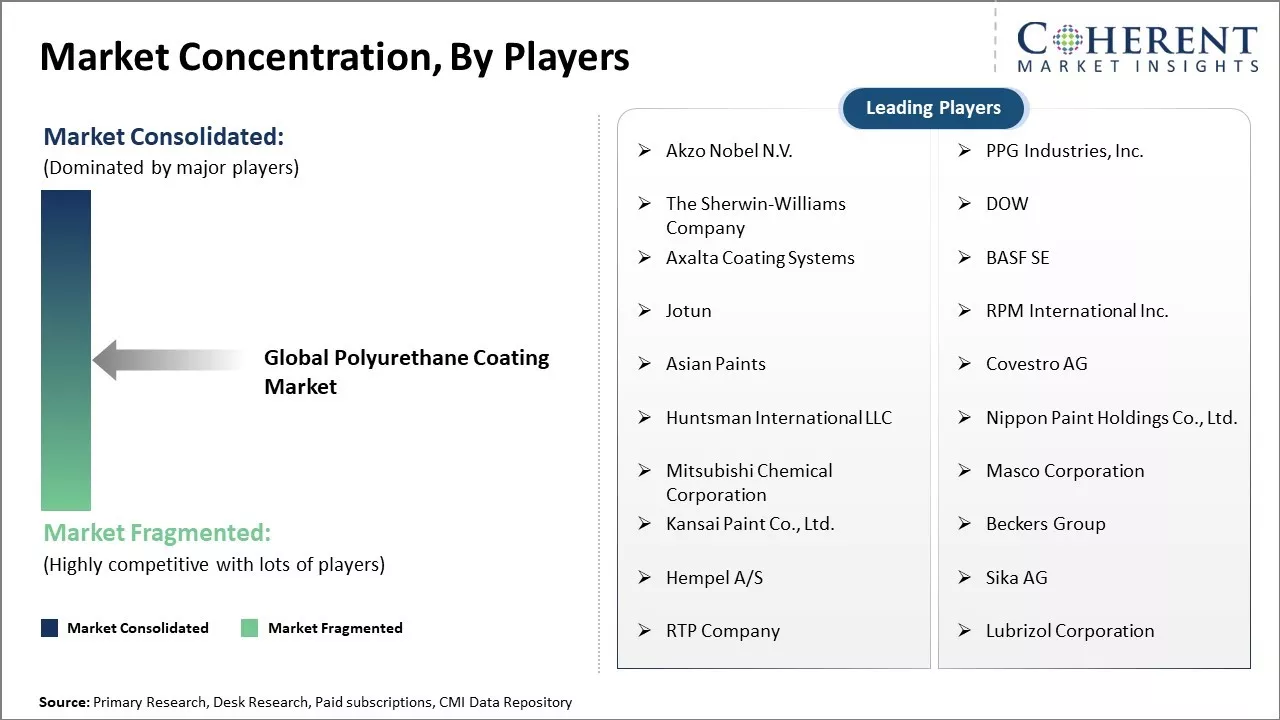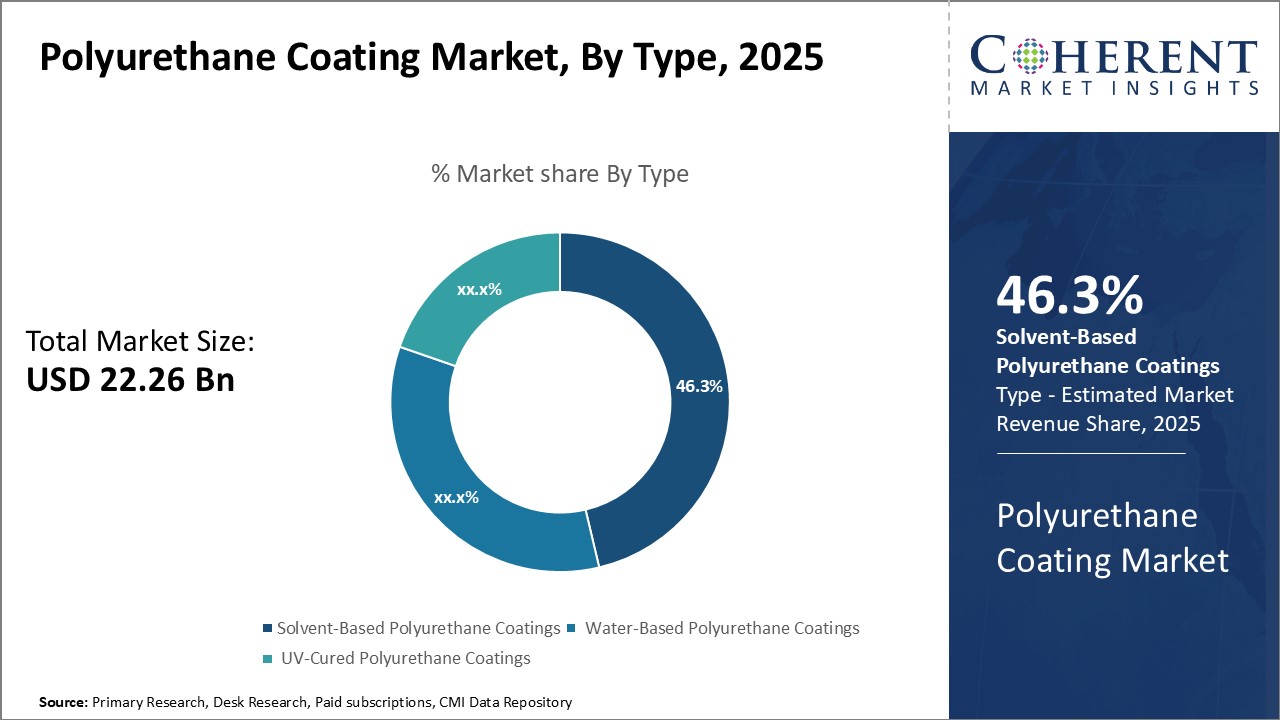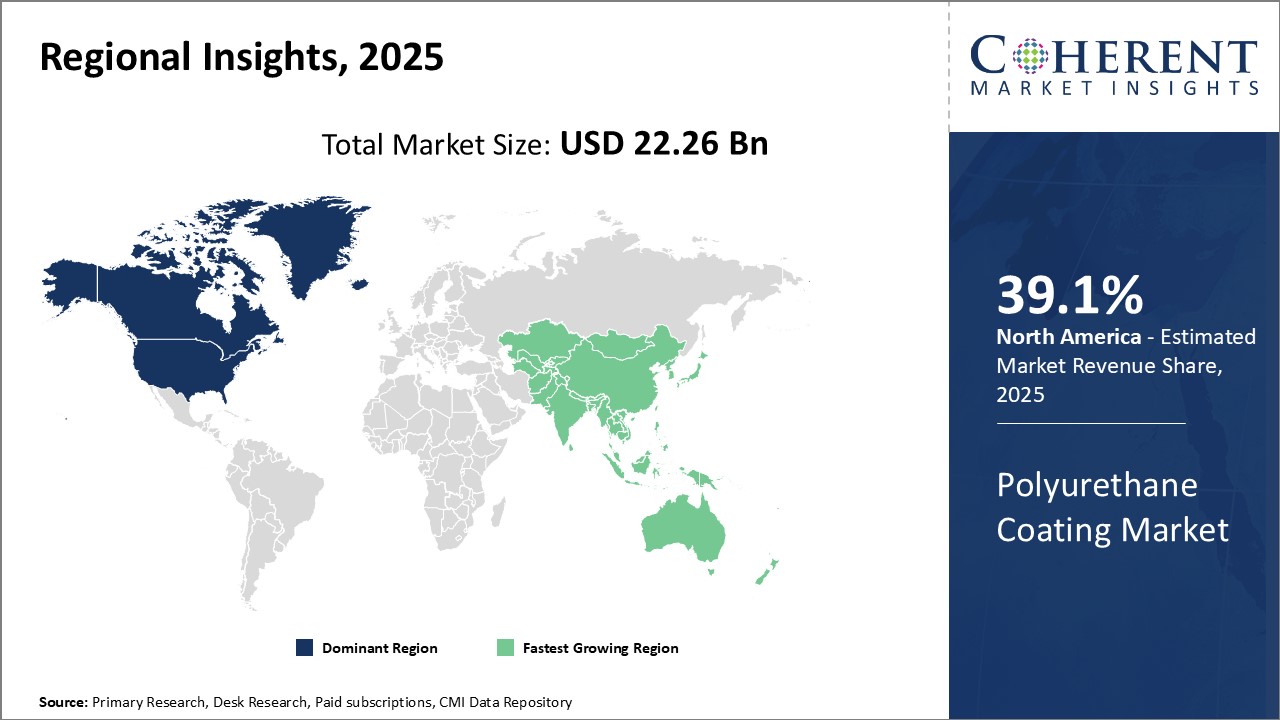Polyurethane Coating Market Size and Trends
The global polyurethane coating market is estimated to be valued at USD 22.26 Bn in 2025 and is expected to reach USD 29.91 Bn by 2032, exhibiting a compound annual growth rate (CAGR) of 4.3% from 2025 to 2032.

Discover market dynamics shaping the industry: Download Free Sample
The global polyurethane coating market is expected grow steadily during the forecast period due to increasing applicability of polyurethane coatings across various industries like automotive, construction, and transportation. Major driving factors include increasing demand from developing nations and rapid industrialization. Additionally, high resistance to chemicals and abrasion along with flexibility makes polyurethane coatings preferable over other alternatives.
Market Driver - Wide applicability in construction, automotive and furniture industries
The global polyurethane coating market is witnessing significant growth primarily due to the wide range of applications in construction, automotive and furniture industries. For instance, according to data from trade government, the U.S. boasts one of the largest automotive markets globally. In 2020, light vehicle sales in the U.S. reached 14.5 million units, solidifying the country’s position as the world's second-largest market for vehicle sales and production. Polyurethane coatings are increasingly being used for protective and decorative purposes in building exteriors and interiors. Their versatility and excellent moisture resistance makes them very suitable for different types of construction materials like wood, concrete, and metals. Whether it is for roof coating, cladding, flooring or bed lining, polyurethane coatings adhere extremely well and form a long-lasting protective layer against wear, tear, moisture, and other environmental effects. The accelerated urbanization and infrastructure development activities all over the world has boosted the demand for polyurethane coatings in construction applications.
In the automotive industry as well, polyurethane coatings are ubiquitous due to their hardness, durability, and aesthetic properties. Both exterior and interior automotive parts such as bumpers, trims, dashboards, etc. extensively employ polyurethane coatings for corrosion protection, surface finishing, and color retention. Especially due to the rising popularity of multi-colored designs, polyurethane-based coatings help automotive Original Equipment Manufacturers (OEMs) and refinishers provide scratch resistance and vibrant glossy looks. Meanwhile, the furniture industry too has emerged as major end-user of polyurethane coatings. Whether applied on wooden furniture, cabinets or upholstery, polyurethane coatings protect the substrates from impact, scuffs, moisture damage and discoloration while imparting an elite high gloss sheen.
Market Concentration and Competitive Landscape

Get actionable strategies to beat competition: Download Free Sample
Superior Properties Like Abrasion Resistance, Excellent Adhesion and Durability
Another key growth driver for the global polyurethane coating market is the set of superior functional properties exhibited by these coatings. Polyurethane coatings demonstrate unparalleled resistance to abrasion, impact and wear due to their tough, flexible and elastic nature. Even with prolonged usage or application in adverse conditions, polyurethane coating films retain their protective capability. This can prolong the lifecycle of assets substantially. Furthermore, polyurethane coatings possess superb adhesive qualities which allow them to form extremely strong bonds with virtually any type of surface. Their adhesion remains unaffected by weathering exposure, moisture, temperature fluctuations, or surface imperfections.
Additionally, polyurethane coatings are extremely durable and can withstand corrosion or degradation when used in outside environments for extended time periods. Important properties like UV resistance, corrosion protection, and chemical resistance ensures polyurethane coatings do not degrade or discolor even after years of service. Whether as roof coatings, floor coatings, or general industrial coatings, their toughness and durability holds up applications with minimal maintenance. The blend of barrier protection and sustainability translates to reduced total cost of ownership for asset owners. All these advanced performance strengths have made polyurethane coatings preferred over alternative chemistries in protective industrial applications as well as maintenance, repair and overhaul activities.
Key Takeaways from Analyst:
The global polyurethane coating market is poised to grow at a steady pace over the forecast period driven by increasing demand from the construction and automotive industries. Polyurethane coatings offer attributes like durability, resistance to corrosion and abrasion which makes them very suitable for use in these end-use industries. Advancements in polyurethane coating technologies are further expanding their applications in newer domains like industrial machinery and wind turbines.
While the market in developed regions like North America and Western Europe may see slower growth rates due to maturity, the Asia Pacific region is expected to witness the fastest gains. This can be attributed to the surge in infrastructure development and automotive production across China, India, and other Southeast Asian countries. Consumerism is on the rise in the region which will bolster demand from general industrial and wood coatings as well.
Fluctuating raw material prices remain a key challenge for polyurethane coating manufacturers. Strict environmental regulations pertaining to VOCs could also restrain revenue growth to some extent over the next few years. However, ongoing R&D towards bio-based coatings and new product innovations centered around performance efficiency are likely to offer opportunities for market expansion.
Market Challenge - Stringent environmental regulations
The global polyurethane coating market is facing stringent environmental regulations imposed by various government organizations across the globe. For instance, regulations like REACH in Europe and Environmental Protection Agency (EPA) regulations in the U.S. are restricting the use of isocyanates, solvents, and VOCs in polyurethane coatings due to their hazardous nature. Polyurethane coatings contain volatile organic compounds (VOCs) in large amounts, which emit toxic pollutants into the atmosphere. Many countries such as India and China and regions have formulated strict norms to control and reduce VOC emissions from coating products. This is negatively impacting the demand for conventional polyurethane coatings. Manufacturers are under pressure to develop newer coating formulations that are eco-friendly and comply with existing environmental regulations. Significant investments are required for R&D activities to replace solvent-borne systems with low or zero VOC waterborne polyurethane coatings. However, waterborne coatings exhibit inferior performance characteristics such as lower durability, scratch and corrosion resistance. Balancing environmental compliance and coating performance remains a key challenge for players in this market.
Market Opportunity - Emerging applications in new industries
The global polyurethane coating market is poised to gain new growth opportunities through emerging applications in several new and niche industries such as automotive and others. With increasing construction of offshore oil rigs, pipelines and ships, the demand for polyurethane coatings is witnessing momentum from the marine industry. These coatings provide critical corrosion protection and durability under harsh environmental conditions. Additionally, the booming electric vehicles industry has opened new avenues for polyurethane coatings in manufacturing battery compartments and electrical connectors. Their excellent adhesion, flexibility, and resistance to extreme temperatures make polyurethane coatings ideal for such applications. Other emerging sectors such as aerospace and aviation also look up to advanced polyurethane coatings for lightweight composite components. If addressed successfully, these new application areas can help offset challenges arising from stringent environmental regulations.

Discover high revenue pocket segments and roadmap to it: Download Free Sample
Insights by type: Superior Durability and Versatility Drive the Demand for Solvent-based Polyurethane Coatings
Within the global polyurethane coating market, solvent-based polyurethane coatings is expected to hold 46.3% of the market share in 2025, owing to their unmatched durability and versatility. These coatings form a tough, flexible, and abrasion-resistant film ideal for applications that demand high performance in harsh conditions. Their ability to adhere strongly to a wide range of substrates makes them the top choice for uses involving metal, concrete, wood, and other industrial materials.
The rugged weatherability of solvent-based polyurethane coatings has made them particularly popular for protecting infrastructure and transportation assets exposed to deterioration from environmental factors. Formulations continue to be optimized for even better UV resistance, corrosion protection, and longevity when facing extreme temperatures, precipitation, and other weather stresses. Their toughness withstands impacts, abrasion, and other physical damages that weakly bonded coatings would fail to resist. As infrastructure ages across regions, maintaining protective coated surfaces becomes ever more important, driving steady consumption.
The automotive industry has also been a stalwart user, relying on solvent-based polyurethanes to safely encapsulate metal vehicle bodies and components. Rigorous testing and certification ensure these coatings can withstand repeated mechanical wash cycles, solvent and chemical exposure during repairs, and long-term outdoor weathering without compromising surface aesthetics or integrity. New paint offerings continue expanding their color palette and special effect capabilities. As global vehicle production increases, so does the need for high-performance automotive coatings.
Insights by application: Architectural Coatings' Aesthetic Versatility Drives Leading Share of Application Demand
The architectural coatings segment dominates the global polyurethane market due to building owners’ large-scale, recurring needs for visually appealing and protective finish coats. This segment is expected to hold 36.3% of the market share in 2025. Polyurethane formulations precisely fill this need by combining easy workability during application with durable, long-lasting, and customizable aesthetic qualities.
Architects and designers value polyurethanes’ limitless color and gloss options, allowing them to precisely achieve any look or special effect specification. Textured finishes mimic natural surfaces like stone and wood, while smooth satin and gloss variants suit modern, minimalist styles. Formulations accommodate intricate application techniques like faux painting or digital multi-colored designs with sharp details. This versatility enables architects to bring even their most elaborate visions to life on building exteriors and interiors.
Building owners also prefer polyurethanes for their proven resistance to weathering, abrasion, chemicals, and other environmental stresses that can compromise aesthetics over time. Specially compounded to resist yellowing, fading, cracking or peeling, these coatings retain brilliant color and gloss for decades with minimal maintenance. Their elastic yet abrasion-resistant film safeguards substrates while preserving pristine coated surfaces that express owners’ brand image. As architectural trends continuously reinvent building aesthetics, polyurethane coatings remain the medium of choice for protective finishes that elevate design.
Regional Insights

Need a Different Region or Segment? Download Free Sample
North America has established itself as the dominant region in the global polyurethane coating market. The region is expected to hold 39.1% of the market share in 2025. The U.S., in particular, accounts for the largest share primarily due to a strong presence of chemical producers and favorable government policies that promote manufacturing activities. Furthermore, growth in the automotive, industrial machinery, and construction industries over the past decade has driven the demand for polyurethane coatings exponentially. Regional players like PPG Industries, Sherwin-Williams, and Axalta Coating Systems cater to over 60.5% of the coating needs of these core end-use industries. These major companies are constantly investing in R&D to develop advanced coating solutions equipped with properties like better abrasion resistance, durability and lower VOC emissions.
Asia Pacific, on the other hand, is projected to be the fastest growing regional market in the coming years. Rapid industrialization and infrastructure development in China, India, and other Southeast Asian countries are expected to fuel the consumption of polyurethane coatings for a variety of applications. A significant portion of regional demand is met through imports mainly from North America and Europe due to limited production capacities of domestic coatings producers. However, international vendors are actively setting up local manufacturing plants to gain easier access to Asian markets and reduce dependence on exports. Meanwhile, governments are encouraging more investments into this sector by offering tax incentives, subsidies and other favorable business policies. If this trend continues, Asia Pacific might surpass North America to become the global leader in polyurethane coating demand within the next decade.
Market Report Scope
Polyurethane Coating Market Report Coverage
| Report Coverage | Details | ||
|---|---|---|---|
| Base Year: | 2024 | Market Size in 2025: | USD 22.26 Bn |
| Historical Data for: | 2020 To 2024 | Forecast Period: | 2025 To 2032 |
| Forecast Period 2025 to 2032 CAGR: | 4.3% | 2032 Value Projection: | USD 29.91 Bn |
| Geographies covered: |
|
||
| Segments covered: |
|
||
| Companies covered: |
Akzo Nobel N.V., PPG Industries, Inc., The Sherwin-Williams Company, DOW, Axalta Coating Systems, BASF SE, Jotun, RPM International Inc., Asian Paints, Covestro AG, Huntsman International LLC, Nippon Paint Holdings Co., Ltd., Mitsubishi Chemical Corporation, Masco Corporation, Kansai Paint Co., Ltd., Beckers Group, Hempel A/S, Sika AG, RTP Company, and Lubrizol Corporation |
||
| Growth Drivers: |
|
||
| Restraints & Challenges: |
|
||
Uncover macros and micros vetted on 75+ parameters: Get instant access to report
Polyurethane Coating Industry News
- In April 2024, Huntsman Corporation, a global manufacturer and marketer of differentiated chemicals, announced the launch of its new SHOKLESS polyurethane systems designed to protect electric vehicle (EV) batteries. These advanced polyurethane solutions are engineered to provide superior shock absorption and thermal insulation, ensuring the safety and performance of EV batteries.
- In 2023, Huntsman Corporation announced plans to launch new coatings products at the European Coatings Show (ECS). The ECS, one of the largest international trade fairs for paint, coatings, sealants, construction chemicals, and adhesives, provides an ideal platform for Huntsman to showcase its latest innovations in the coatings industry.
- In 2023, Covestro , a leading manufacturer of high-tech polymer materials and solutions commenced the production of polyurethane elastomer systems at its newly established plant in Shanghai, china . This significant investment, amounting to several million euros, is part of a broader strategy to enhance its elastomer raw materials capabilities.
- In 2022, BASF SE, a chemical company introduced an innovative polyurethane product known as RODIM film. This advanced film is designed to protect automotive paint, offering an invisible layer of defense. RODIM film is expected to deliver multifaceted and long-lasting protection for car coatings, safeguarding vehicles from various environmental factors and wear. This launch underscores BASF SE's commitment to enhancing automotive durability and aesthetics through cutting-edge materials technology.
*Definition: The global polyurethane coating market consists of manufacturers, suppliers and end-users of polyurethane coating products across various industries such as construction, automotive, furniture and others. Polyurethane coatings provide properties like durability, flexibility and resistance to abrasion, sunlight and chemicals, making them suitable for a variety of applications. Key players in this market offer different types of polyurethane coatings like thermoplastic and thermoset for use in architectural, automotive, industrial, wood, packaging, and other applications.
Market Segmentation
- Type Insights (Revenue, USD Bn, 2020 - 2032)
-
- Solvent-Based Polyurethane Coatings
- Water-Based Polyurethane Coatings
- UV-Cured Polyurethane Coatings
- Application Insights (Revenue, USD Bn, 2020 - 2032)
-
- Architectural Coatings
- Automotive Coatings
- Industrial Coatings
- Wood & Furniture Coatings
- Others
- Regional Insights (Revenue, USD Bn, 2020 - 2032)
-
- North America
- U.S.
- Canada
- Latin America
- Brazil
- Argentina
- Mexico
- Rest of Latin America
- Europe
- Germany
- U.K.
- Spain
- France
- Italy
- Russia
- Rest of Europe
- Asia Pacific
- China
- India
- Japan
- Australia
- South Korea
- ASEAN
- Rest of Asia Pacific
- Middle East
- GCC Countries
- Israel
- Rest of Middle East
- Africa
- South Africa
- North Africa
- Central Africa
- North America
- Key Players Insights
- Akzo Nobel N.V.
- PPG Industries, Inc.
- The Sherwin-Williams Company
- DOW
- Axalta Coating Systems
- BASF SE
- Jotun
- RPM International Inc.
- Asian Paints
- Covestro AG
- Huntsman International LLC
- Nippon Paint Holdings Co., Ltd.
- Mitsubishi Chemical Corporation
- Masco Corporation
- Kansai Paint Co., Ltd.
- Beckers Group
- Hempel A/S
- Sika AG
- RTP Company
- Lubrizol Corporation
Share
Share
About Author
Vidyesh Swar is a seasoned Consultant with a diverse background in market research and business consulting. With over 6 years of experience, Vidyesh has established a strong reputation for his proficiency in market estimations, supplier landscape analysis, and market share assessments for tailored research solution. Using his deep industry knowledge and analytical skills, he provides valuable insights and strategic recommendations, enabling clients to make informed decisions and navigate complex business landscapes.
Missing comfort of reading report in your local language? Find your preferred language :
Transform your Strategy with Exclusive Trending Reports :
Frequently Asked Questions
EXISTING CLIENTELE
Joining thousands of companies around the world committed to making the Excellent Business Solutions.
View All Our Clients
